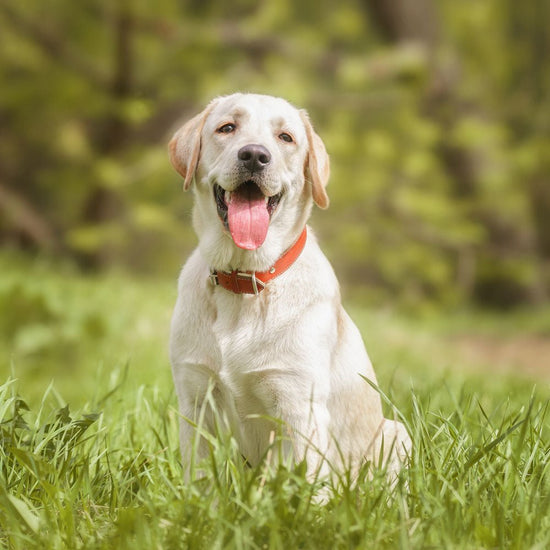

Your basket is currently empty.

Free UK Delivery. Exclusions apply.
Don't miss out! Add these must haves now.
Are you in the right place?
Please select your location so we can direct you to the right store...

Labrador
Labradors are friendly, tail-wagging people pleasers. Originally bred as gundogs to retrieve live game, they’ve brought their natural instincts and enthusiasm to ball games and modern family life.

While Labradors are traditionally sporting dogs, their intelligence and eagerness to please have made them the go-to choice for roles such as guide dogs, therapy animals, detection dogs, and, of course, family pets.
Known for their good-natured temperament, Labs generally get on brilliantly with children, other dogs, and just about everyone they meet. That said, no dog should be left unsupervised with young children, and even the gentlest Lab may guard food or react to unfamiliar settings, like a boarding kennel or vet clinic.
Before you fall head over heels, it’s worth taking a moment to consider a Labrador’s needs. With the right care, Labs often live well beyond 10 years – and they do best with plenty of physical activity and mental stimulation. All perfectly manageable in an urban setting, as long as you plan ahead.
Yes and no—names, crossbreeds, and official colour terms can cause a lot of confusion here. Labrador Retrievers and Golden Retrievers are two distinct breeds: Labradors have short, dense coats, while Goldens have longer, feathered fur. A cross between the two is sometimes referred to as a Golden Labrador or Goldador.
Adding to the mix-up, some people mistakenly use “Golden Labrador” to describe a yellow Labrador Retriever—one of the breed’s standard colours alongside black, chocolate and liver.
Labradors are deservedly popular – but with that popularity has come a few health challenges. The good news is that responsible breeders now carry out health screening to help reduce the risk of inherited conditions. That said, no dog is entirely risk-free, and things like diet, exercise, training and socialisation all play a big part in supporting your Labrador’s long-term health.
Labradors can be prone to hip and elbow dysplasia – developmental joint concerns that may affect mobility over time. The severity can vary from dog to dog. Some cases may require surgical support, particularly with elbows, while others can be managed with supplements, weight management and lifestyle adjustments recommended by your vet.
Responsible breeders use the BVA/KC screening scheme to assess joint health, using X-rays, prior to breeding:
A puppy’s first health check is an important opportunity to detect any early signs of heart issues. One example is a heart murmur caused by Tricuspid Valve Dysplasia (TVD), a congenital condition that may be picked up during a puppy check.
Labradors can develop a range of eye conditions, including inherited ones:
Those adorable floppy ears can trap moisture, especially after swimming – creating the perfect environment for infections. Regularly using a vet-recommended ear cleaner can help keep ears healthy. Follow our guide on how to clean your dog's ears.
Labradors can be prone to the occasional tummy trouble – and their love of food doesn’t always help:
As well as the usual culprit, fleas, Labradors can get a variety of skin conditions:
As Labradors age, they can develop new health issues. Knowing what to look out for helps you support them and seek veterinary advice early.
Signs that your Labrador might be developing a heart concern can include tiring more easily, a persistent cough (often at night), changes in appetite, gradual weight loss or a swollen belly caused by fluid build-up. In later life, some Labradors may also experience a condition called Laryngeal Paralysis – where the soft tissues around the airway become less effective. This can make breathing noisier or more effortful, especially during warm weather or physical activity.
Hormonal (endocrine) concerns are not unusual in senior Labradors:
Like many breeds, Labradors can be affected by various types of cancer as they get older. One particularly serious form is hemangiosarcoma – a fast-growing tumour that often develops on internal organs like the spleen or liver. Unfortunately, it’s often only discovered when it causes internal bleeding. Signs such as sudden weakness, collapse or pale gums should always be treated as an emergency – prompt veterinary care is essential.
While rare, two inherited conditions sometimes come up in Labrador forums or conversations with breeders:
Labradors might look fully grown by 12 months, but they usually don’t finish maturing until around 18-24 months. Their bones and joints are still developing during this time, so giving them the right balance of diet and exercise early on can really help support healthy growth.
Joint supplements may be helpful at different stages of a Labrador’s life – from supporting healthy development during growth, to helping maintain mobility in active dogs or as signs of slowing down start to appear.
Labradors love to move – and love to learn.
Shedding: Labs shed year-round but also “blow” their coat twice a year, when their hair comes out in handfuls. Brushing a few times a week – daily during shedding season – helps manage loose hair. Because of all this shedding, if someone in your household has dog allergies, this may not be the breed for you.
Bathing: Use a gentle shampoo and remember that too many baths can disrupt the skin’s natural balance. Consider skin and coat supplements if your Lab is a mud magnet and needs regular baths.
Ears & Paws:
Dental Care: Start young! Use a finger toothbrush and yummy meat-flavoured doggy toothpaste. Dental treats can also be a tasty way to help with oral health.
With the right care, Labradors give back everything you put in – and then some. Their loyalty runs deep, their joy is infectious, and yes, they’ll probably leave a few muddy pawprints along the way. But for most Labrador owners, that’s all part of the charm. These affectionate, eager-to-please dogs thrive on connection and become true members of the family.

Footer